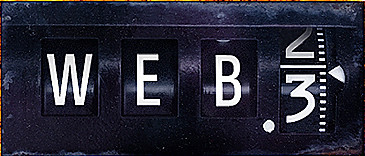Web 3.0: Notes from the future


At the Web 3.0 conference in Santa Clara October 16th and 17th we dived into some fascinating glimpses of the future. Web 3.0 isn’t just a suffix upgrade, rolling over from the increasingly fuzzy buzz around Web 2.0.
This conference was an attempt to bring some further definition to the semantic web, a future where machine understanding of information will provide a much more intuitive user experience of a seamless web that is accessible using natural human language.
The value of the semantic web to enterprise collaboration cannot be overstated – this is key to connecting silos and tagging information so it can be successfully retrieved in context, and information relationships and associations defined.
The conference had an entertainingly split personality comprised of marketing and advertising practitioners keen to exploit any advances in the ability to provide contextual marketing related to specific web content, including email, and the brilliant minds who are driving the future of the machine intuitive web forward.
Yahoo were a strong presence with their search monkey search engine and the launch of ‘social suite’ on the Y!OS 1.0 (Yahoo Open Strategy) developer platform first announced in April.
Social Suite aims to leverage Yahoo’s (still in limited beta) developer program to attempt to homogenize the currently heterogeneous web under single mechanisms.
So on a foundation of one social graph and profile record, Yahoo mechanisms for accessing and mashing up data and a single framework for developing apps would standardize around Y!OS. RDF query languages are at the heart of the semantic web, and Dave Beckett of Yahoo at one point defended SPARQL of which he is a key developer.
The stakes are high in this area as the query language is foundational to all development. While Yahoo attempt to pull the existing web together, Freebase, who were well represented at Web 3.0 is building an ‘open, shared database of the world’s knowledge’ accessed by the ‘Metaweb Query Language’ (MQL) which allows deep nesting of contextual information.
The Freebase Parallax search engine, which I have written about here before, is one of a number of fascinating tools built to access and manipulate the interlinked foundational information in Freebase.
The language of triples, predicates and Resource Description framework (RDF) is likely to be the information organizing lingua franca of the near future.
The advertising world is keeping a close ear to the ground to identify the standards that will allow them to serve you up much more accurate contextual information. Amiad Solomon, CEO of Peer 39 and one of the world's leading experts on the application of semantic technology to next-generation online advertising, showed some toe curlingly inappropriate ads next to content from today’s web. (Michael Utvich, an attendee, expressed concern to me about just how annoying the web is going to be if the powerful new contextual tools are used in crass ways. Keywords are just the start of a far more intrusive ‘contextual’ future).
Rapp played a powerful role in the conference and demonstrated great depth of insight into intelligent use of the increased powers of the semantic web.
I moderated a lively panel on Enterprise Information Management where we attempted to flesh out the impact and benefits the semantic web would have on a notional big pharma company: the four panelists pitched me their services.
Pharma, with its vast spending on ontologies and taxonomies, is an intriguing prospect for Web 3.0 and an interesting case history for the transparent corporation. The classic information silos would be broken down and the global collaborative possibilities created by contextual interlinked data would allow unprecedented access to information. The different units – internal R&D, partners and marketing, would all be accessing the same information and work as a giant interlinked team.
The near future is going to be an extremely exciting period in the development of the web, and this conference was a terrific harbinger of the great changes on the horizon.